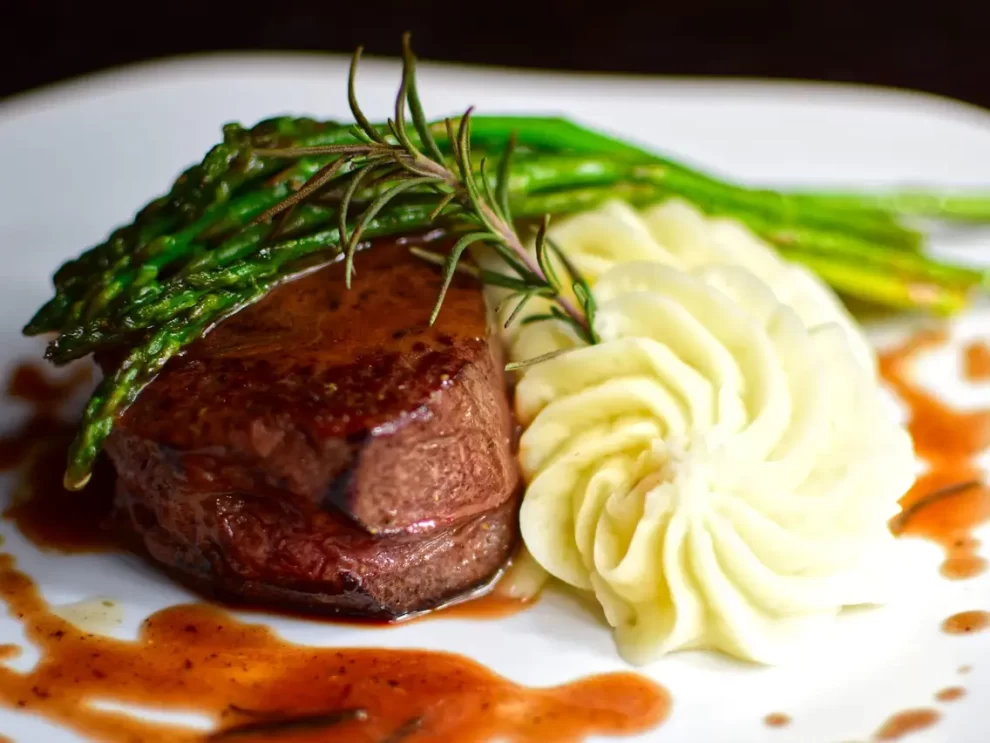Bryan and Michael Voltaggio, the coowners of Voltaggio Brothers Steakhouse at MGM National Harbor in Maryland, told Business Insider there are telltale signs that differentiate luxury steak houses from more mediocre options.
The former “Top Chef” contestants didn’t grow up eating at steak houses, but they both had formative experiences at them when they were chefs in training.
“That’s probably one of the most expensive experiences you’re going to have,” Bryan told BI in an interview ahead of Food Network’s South Beach Wine and Food Festival.
Since dining at steak houses can be expensive, the chefs shared five signs diners should look out for to help them know if they’re eating at a good establishment.
A good steak house shouldn’t be inexpensive or easy to book
Meat is expensive to source, Michael said, and the restaurant’s price range should reflect that.
“Steak houses should not be cheap, and if they are, I would assume that they figured out how to cut corners somewhere,” he said.
The younger brother pointed to rising food costs and said it makes sense for everything from a side of spinach to a dish of mac and cheese to have a high price tag.
Michael also said to proceed with caution if it’s easy to land a prime reservation.
“I think if you can get an eight-top last-minute at 8 p.m. on a Friday or Saturday night, that’s probably a good reason to not go there,” he told BI.
If there are multiple times available on a given night, that tells him there’s not a huge demand for the restaurant.
The restaurant should be transparent about how it sources its meat
Both brothers told BI that at a luxury steak house, you should be able to get the story behind what you’re eating.
Bryan recommends asking questions after looking over the menu.
“If you go to a place that can’t really back up their sourcing and you’re not really understanding where the meat is coming from, especially when they’re charging a premium for it, then I would have concerns,” the restaurateur said.
Michael added that the same is true for everything else on the menu — from seafood entrées to vegetarian dishes, ingredient quality matters, he said.
Pay attention to the whole menu — especially the starters and salads
Michael said he can usually tell if he’s going to have a good experience from the first dish or two.
He calls starters a “first impression” and said it’s a great sign if a steak house doesn’t treat them as an afterthought.
“If you’re not getting the quality that you’re looking for in the starters and salads,” he added, “you can pretty much guarantee that lack of focus would translate into the meat as well.”
So if you get a wilted salad or slimy shrimp cocktail to start your meal, he suggests changing or ordering one $150 rib eye instead of two.
Michael also recommends looking at online customer reviews of starters and shellfish to see if there are notes on quality. Pay attention to which comments show up consistently and which are one-offs, he added.
“For me, that’s the best resource to get legit information,” he said. “If I can go somewhere and know that I can eat raw oysters there, then everything on the menu is gonna be good.”
Beware of a chef who’s overpromising
The Voltaggios said their menus are written simply, but the finished dishes are more detailed and meant to wow diners.
“We write ‘shrimp cocktail’ and just send it out,” said Michael. “But we add puffed shrimp crackers, our cocktail sauce has our own little twist, and then we season the shrimp with Old Bay.”
Intricate menu descriptions aren’t always a bad sign, but Michael said if a chef underdelivers on the first few dishes, the rest of the meal isn’t looking promising.
If the knives aren’t sharp, other service details may be dull
The brothers agree that so much of the experience lies in the details, and Bryan said one of his biggest red flags at steak houses is dull steak knives.
It could just be a sign of a busy eatery, but the chef called it an important service element that shouldn’t be overlooked. It gives him a peek into the restaurant’s general attention to detail.
A dull steak knife can take away from diners’ overall experience, he said, which is the main reason to go to a steak house to begin with.
Plus, Bryan continued, it can affect the texture of the steak as well as the way it tastes. “Having to saw at” a steak instead of getting a clean slice can impact the meat’s ability to retain moisture.
“There’s nothing worse than being in a high-end, high-check-average steak house and you’re handed a dull knife,” he told BI. “I’m not saying it has to be a razor, but I shouldn’t have to work hard to cut through my piece of meat.”
Source: Business Insider

























